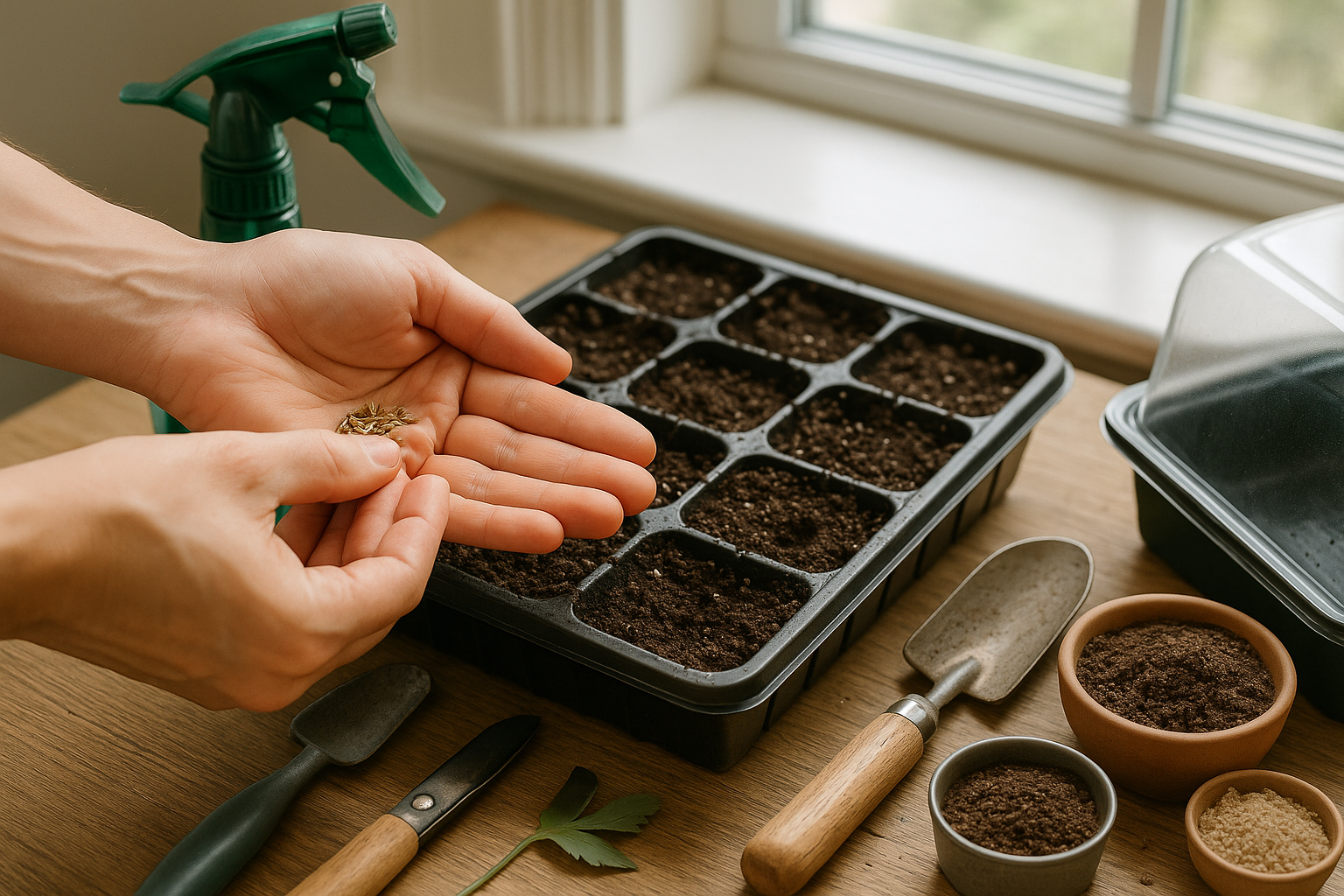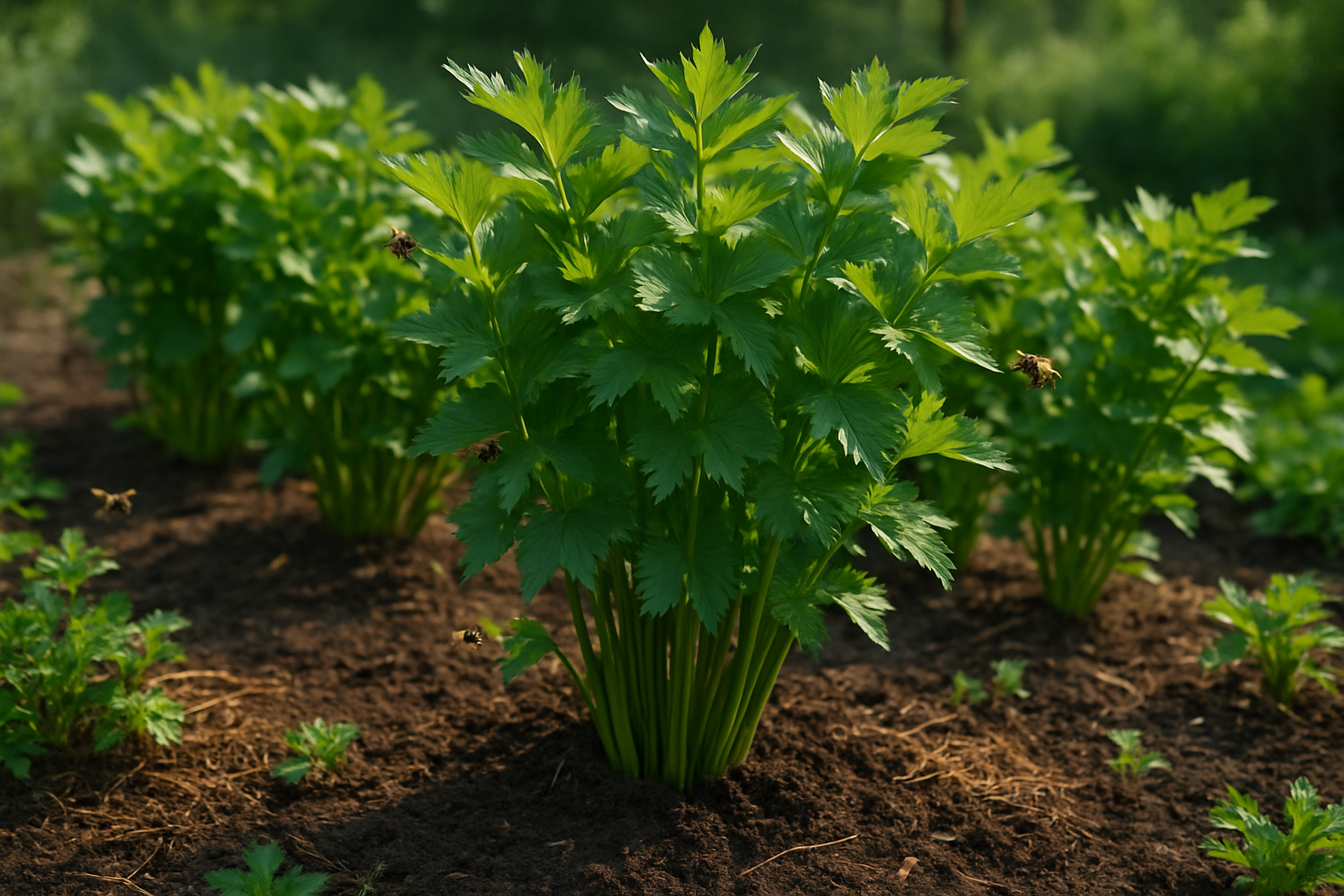Introduction
If you’ve ever wondered how to grow lovage from seed, you’re in the right place. Lovage is a tall, leafy herb cherished by chefs for its bold, celery-like flavor—a perfect addition to soups, stews, and salads. Beyond the kitchen, it’s a striking perennial that attracts pollinators and adds structure to your garden beds.
The good news? Lovage is surprisingly easy to grow from seed, making it accessible even for beginner gardeners. In this article, you’ll learn simple tips to start your own lush lovage patch and enjoy fresh, flavorful leaves right outside your door.
Getting Started with Lovage Seeds

Lovage is a tall, perennial herb with a flavor reminiscent of celery, making it a unique addition to both kitchen gardens and culinary dishes. Known for its vigorous growth, lovage can reach up to six feet in well-drained, fertile soil, thriving best in cooler climates with partial shade or full sun.
Many gardeners prefer starting lovage from seeds because established plants can be hard to find at nurseries. Growing from seed also gives you access to a wider range of varieties and fresher stock.
Sowing seeds indoors is a popular choice if you want a head start on the season. You can plant seeds in small pots or seed trays about six to eight weeks before your last expected frost. Keep the soil moist and warm (around 65-70°F) to encourage even germination, which typically takes 10-14 days.
Direct sowing outdoors works well too, but should be done after the danger of frost has passed and the soil warms in spring. For most regions, this falls between late April and mid-May. If you’re short on indoor space or want to skip transplanting, direct outdoor seeding is a great low-maintenance option—just remember to thin seedlings so mature plants have plenty of room to grow.
Whichever method you choose, consistent moisture and patience are key since lovage can sometimes be slow to sprout. But the effort pays off with a resilient, flavorful perennial that will thrive for years to come.
Choosing the Right Seeds and Supplies
When starting your lovage garden, picking quality seeds makes all the difference. Choose lovage seeds from reputable garden centers or trusted online suppliers, as freshness and proper storage significantly impact germination rates. Look for packets with clear labeling and recent packaging dates.
For soil, lovage thrives in well-draining, nutrient-rich potting mix—ideally one with added compost or organic matter. If you’re starting seeds indoors, use shallow seed trays or small pots with drainage holes to prevent excess moisture. Seed starting kits are handy and often come with everything you need.
You’ll also need a spray bottle for gentle watering and a clear plastic dome or plastic wrap to keep humidity consistent during germination. Some gardeners swear by pre-soaking lovage seeds for 6-12 hours before planting—this softens the seed coat and can improve germination, though it’s not strictly necessary.
To prep, fill your trays with damp soil, plant seeds about 1/4 inch deep, and mist lightly. Place trays in a warm, bright spot out of direct sunlight. By carefully selecting your seeds and supplies and following these simple prep steps, you’ll set the stage for healthy, vigorous lovage seedlings.
Sowing and Germination Tips

Starting lovage from seed can test your patience, but following a few simple steps will boost your chances of success, whether you’re sowing indoors or outdoors.
Indoor Sowing
Begin 6-8 weeks before the last frost date. Fill seed trays or small pots with a moist, quality seed-starting mix. Sow seeds about 1/4 inch deep—lovage prefers a bit of darkness to germinate. Space seeds 1-2 inches apart to allow room for growth and airflow.
Cover trays with plastic wrap or a humidity dome to retain moisture, and place them in a bright spot, but out of direct sunlight. The ideal soil temperature for germination is 60-70°F (16-21°C); a seedling heat mat can help if your space is chilly. Lovage seeds are famously slow to sprout, sometimes taking up to three weeks, so keep the soil moist but never soggy, and be patient.
If mold appears, remove any covers for a few hours and improve air circulation.
Outdoor Sowing
For direct sowing outdoors, wait until the soil has warmed in spring. Choose a sunny to lightly shaded area with rich, well-draining soil. Sow seeds in rows, spacing them 18-24 inches apart, as mature lovage plants grow large. Water gently after sowing and mark the spot since seedlings emerge slowly.
Transplanting and Care
Once indoor seedlings have at least two true leaves and night temperatures are above 50°F (10°C), harden them off by gradually introducing them to outdoor conditions over a week. Transplant carefully, keeping root systems intact, and maintain spacing to encourage healthy growth.
Always keep soil evenly moist during early establishment and weed around young plants to reduce competition. With patience and a little attention, you’ll be rewarded with lush lovage plants that thrive for seasons to come.
Planting Lovage in the Garden
Transplanting lovage seedlings or thinning direct-sown plants is best done in early spring, once the risk of frost has passed and the soil is workable. When transplanting, handle seedlings gently and plant them at the same depth they were growing in their pots. Space each plant at least 24 to 36 inches apart—lovage can grow quite tall and bushy, so giving it plenty of room is essential.
Choose a planting site with full sun or partial afternoon shade, as lovage thrives with plenty of light but benefits from some protection against intense midday heat. Prepare the soil by adding plenty of organic matter like compost or well-rotted manure. Ensure the soil drains well but retains enough moisture to support the deep taproots. Avoid areas where water tends to pool or where the soil is compacted and hard.
A common beginner mistake is not giving lovage enough space; overcrowded plants compete for sunlight, airflow, and nutrients, which can cause spindly growth or increase susceptibility to disease. Another frequent error is planting in poor soil—while lovage is a robust herb, it still requires fertile, loose earth to flourish.
Finally, don’t neglect watering young plants. Keep the soil consistently moist while the roots establish, but avoid waterlogging. Regularly check during dry spells to prevent wilting, especially in the first few weeks after transplanting or thinning.
By paying attention to these basics, your lovage patch can become a lasting, productive feature in your garden.
Caring for Lovage as It Grows
Caring for lovage isn’t demanding, but a few smart habits can keep your plants lush and productive all season. Water regularly, especially during dry spells—aim for moist, not waterlogged, soil. A layer of mulch, like straw or shredded leaves, helps retain moisture and suppress weeds, making maintenance easier.
Feed your lovage in early spring with a shovel of well-rotted compost or a sprinkle of organic all-purpose fertilizer; repeat once in midsummer if growth slows. Watch for pests like aphids or celery leaf miners—knock aphids off with a jet of water or introduce beneficial insects like ladybugs. For leaf miners, snip and remove any affected leaves quickly to prevent spreading.
Fungal diseases, such as powdery mildew, can appear in humid weather; increase airflow by spacing plants well and pruning away crowded stems. Pruning is also key for healthy, bushy lovage. Regularly harvest outer leaves for kitchen use, and snip off flower stalks as soon as they appear if you want to keep the flavor rich and extend the leafy harvest.
By staying attentive to these details, you’ll enjoy robust lovage that’s perfect for soups, stews, and salads right from your own garden.
Harvesting and Using Lovage
Lovage is ready to harvest when the stems are sturdy, green, and about 12 to 18 inches tall—usually in late spring to early summer. To pick the leaves, simply snip them off with clean scissors or pinch them gently, being careful not to strip the plant bare so it can continue producing.
Harvest stems in the morning for the freshest flavor, cutting them close to the base. Both leaves and stems have a strong, celery-like taste and work well chopped fresh into soups, stews, and salads for a bold, herbal kick. You can also use the hollow stems as eco-friendly straws for savory drinks like Bloody Marys.
For future harvests, let some plants flower and form seed heads. Once the seeds turn brown and dry, shake them out over a tray and store them in a paper envelope in a cool, dry spot.
Lovage roots can be divided in early spring or fall—simply dig up the plant, separate a section with its roots, and replant it right away. Sharing seeds or divisions with friends is easy and helps ensure you have a steady supply of this flavorful and versatile herb year after year.
Conclusion & Quick Tips
Growing lovage from seed is surprisingly straightforward, making it a great choice for both beginners and seasoned gardeners. To increase your success, start seeds indoors early, keep the soil consistently moist, and transplant to a sunny, well-drained spot.
Keep in mind that lovage grows tall—give it plenty of space and provide support if needed. Mulching around the base helps retain moisture and control weeds.
For more information, explore detailed growing guides or try companion planting lovage with carrots or tomatoes to create a thriving, productive garden. With just a little care, you’ll enjoy this versatile herb for seasons to come.
